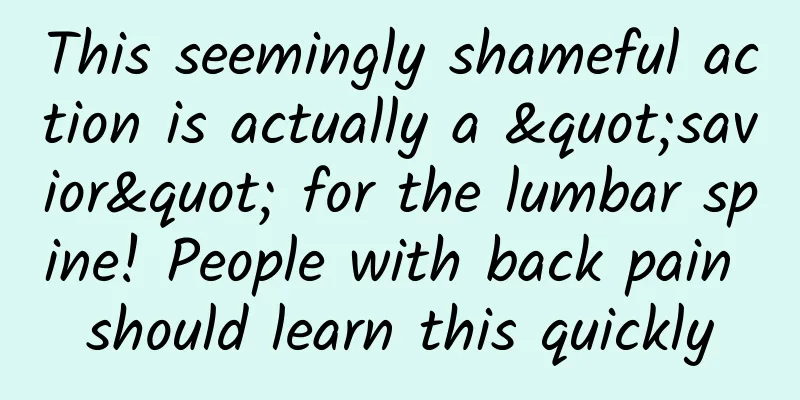This seemingly shameful action is actually a "savior" for the lumbar spine! People with back pain should learn this quickly

|
I once saw a short video in which a blogger seriously taught everyone how to use correct knowledge of body mechanics to protect their waists while doing housework. Specifically: stick your butt out. Image source: Internet After that, I saw an even more outrageous video: How to bend down to pick up something correctly? Image source: Youtube content creator beardthebestyoucanbe In fact, the secret is - stick your butt out. Eh? Why do they both stick their butts out when doing housework or picking up things to protect their waists? Learning to stick out your butt is a blessing for your lumbar spine To be honest, if you don’t know how to stick out your butt, it’s your waist that will be hurt! The healthy human spine has a natural curvature, which can be described as convex in front and curved in the back (actually it is convex in front and concave in the back ...). You can refer to the picture below: the thoracic part bulges backwards, and the lumbar part bulges forward. Image source: Kyphosis (roundback) of the spine - orthoinfo - aaos. OrthoInfo. (n.d.). This setting allows us to place moderate pressure on the spine when we are in a naturally upright static posture, and can also effectively cushion the ground reaction force from the soles of the feet when we move. When we violate this setting and assume a different posture, the lumbar spine is burdened again: Image source: Made by myself At this time, if you cannot flex your hip, the lumbar spine will bear the burden directly. Let’s take a look at how much pain the waist suffers for people who don’t know how to stick out their butts. Image source: Muscle and Motion It can be seen that when the lower back is bent, the bone protrusion behind the spine is like the thorns on the back of a dinosaur, which is very prominent. We can even stand up and do this movement now and touch the center of our lower back - can you feel the sharp tip that is obviously painful? At this time, the ligaments covering these tips are passively stretched and the tension is extremely high. The muscles next to the vertebrae of the spine are unable to work to share the pressure, and we can only rely on these ligaments to pull our heavy torso. You can imagine that the white ligament in the picture above is replaced with a rubber band. If it is stretched like this for a long time, it will eventually lose its elasticity and collapse. If you maintain an "anti-human" posture for a long time, various lumbar problems will follow. But! What if we don’t let the lower back arch, but slightly stick out the buttocks, so that the spine is relatively straight, or even returns to the position with natural curvature in the picture above? Image source: Muscle and Motion Do you see the red part in the picture? When we stick our buttocks out and the lumbar spine is in a straight or relatively neutral position, the muscles around the lower lumbar spine are actually activated! The ligaments that were just forced to stretch and suffer can also get a rest. Most importantly, the muscles of the buttocks and thighs can also work more efficiently and labor-savingly. You should know that the gluteus maximus in the buttocks and the quadriceps in the front of the thigh are two of the largest muscles in the human body. When they start to activate correctly, they will bring huge power and energy to our hip joints. The correct butt-sticking posture can protect your lumbar spine from strain and the risk of herniated disc for the next ten or even decades. Dwayne Johnson can do hip thrust training with such heavy weights, which requires the participation of these two muscle groups. Of course, stable control of the lumbar spine and correct coordination of multiple parts of the body are also essential. I really didn't expect that a small action of sticking out your butt would cause a series of changes in your body. This is also why "hip flexion" (the scientific name for sticking out your butt) is always the first lesson in fitness. To put it in depth, this class is about learning how to correctly fold the upper body forward with the hip joint as the axis, squat and move the hips backward while maintaining the natural slightly lordotic curvature of the lumbar spine. This lays a solid foundation for more complex movements and protects our lumbar spine to the greatest extent. To put it simply: to protect your waist, you must learn to stick out your butt. Photo courtesy of Muscle and Motion Butt, which way is better to stick it out? It's just sticking your butt out. What's so difficult about that? But many people really don’t know how to do it! For example, some people have weak core strength, and after bending their backs for a while, they feel tired in the waist, and then arching their backs will cause more damage to the lumbar spine. Some people can’t feel the linkage of their joints. They think they should stick their buttocks out, but the part that actually moves the most is the knees. If the buttocks are not stuck out properly, the knees will start to feel uncomfortable first. What's worse is that the range of motion of the hip joint is limited and the posterior chain is tight. When I stick my butt out, my thighs feel stretched. I have to bend over slightly to make myself feel more comfortable, and I bend over while sticking my butt out... Considering that most people should be sitting, we can feel the correct position of the hips through sitting. The brain learns to feel the correct position of the buttocks so that it can better control it to stick it up in the future. 1 Find your own neutral position First, let's put our hands on the hard part of the front of the pelvis, wrapping our hands around the pelvis like a clamp and feeling its movement. Image source: Made by myself Next, we push the lower back forward to increase the curvature of the lumbar lordosis. At this point, you will feel the fingers on the front of the body falling lower. When you reach your limit, you can look down at your pelvis - this is the maximum angle of your pelvic anterior tilt. Image source: Posture Direct Next, we do the opposite action and let the lower back arch up like a shrimp. When you reach your limit, you can look down at your pelvis - this is the maximum angle of your pelvic posterior tilt. Image source: Posture Direct When we practice leaning forward and backward like this several times, we can get a good sense of the limits of our pelvic rotation forward and backward. At this point, we let the pelvis rest at the middle point between these two extremes - this is your pelvic neutral position, and the pressure on the lumbar spine is also less. Because everyone's pelvic tilt range of motion is different, the neutral position at the midpoint is also slightly different. Now that you have mastered the first level of movements, it's time to get up and practice! 2 Practice proper hip flexion In a standing position, with feet shoulder-width apart, we once again complete the forward and backward tilt of the pelvis to confirm our neutral position. Keeping this tension around the pelvis and abdomen, the upper body is straight and folded forward with the hips as the axis, and the buttocks move back naturally. You can imagine that there is a wall behind our buttocks, and we need to hit it with our buttocks. It should be noted that during this process our knees will only move slightly forward. If the distance we run forward is too large, it means that there is a problem with the control and position of the hips! Image credit: Repel Bullies At the same time, we will gradually shift the center of gravity from the middle of the foot to the back. You can try it a few more times to feel the change of the center of gravity, the order of muscle activation and the coordination of the body linkage. Practice makes perfect, my friends! If you still have trouble finding the feeling when you first start practicing, you might consider putting a stick on your back. Keep your back and the back of your head against the stick throughout the whole process. If you can complete the movement trajectory completely, it means you are doing it right! Image credit: Prokinetixrehab Another point worth mentioning is that the hip hinge action performed by the blogger at the beginning when doing housework is actually a bit too much (they are funny content creators, so they must be exaggerated). We should not imitate them to this extent! Safe, efficient and correct butt sticking is a good butt sticking and good for the butt! I really didn’t expect that one day I would teach you how to “stick your butt out”, but please don’t be shy. Analyzing this concept thoroughly will definitely be a +10,000 merit, and your waist will cry and thank you! After all, people who stick out their butts are the ones who really care about their waists. References [1] Nachemson, AL (1976). The lumbar spine an orthopaedic challenge. spine, 1(1), 59-71. [2] Wilke, HJ, Neef, P., Caimi, M., Hoogland, T., & Claes, LE (1999). New in vivo measurements of pressures in the intervertebral disc in daily life. Spine, 24(8), 755–762. https://doi.org/10.1097/00007632-199904150-00005 Planning and production Source: DingXiang Doctor (ID: DingXiangYiSheng) Editor: Yang Yaping Proofread by Xu Lai and Lin Lin |
<<: It's a fake volcano that spits mud!
Recommend
China Automobile Dealers Association: Monthly Report of the Connected New Mobility Branch in September 2020
01. Market performance 01National online car-hail...
Wang Fang: Beautiful Greater China
: : : : : : : : : : : : : : : .mp3 8.63M ├──【Free ...
The ninth season of "The Big Bang Theory" begins, Sohu Video is about to usher in the second golden age of American TV series
When talking about American TV series in China, w...
Are the materials submitted for information flow advertising repeatedly rejected? You haven't learned this internal audit rule yet!
With the 19th National Congress of the Communist ...
Customer acquisition costs dropped by 50%! Short video marketing skills in the wedding industry!
With the continuous development of my country'...
Autonomous driving technology brings the moral dilemma of machines forward. How should algorithms choose between life and property?
In the field of science fiction, the moral and et...
Why Apple iPhone does not support dual SIM cards? Because the interests of operators will be damaged
Before each generation of iPhone is released, the...
Didi Friends Chain
SEO site introduction Souwai Didi Friendly Link P...
Satellite photography: What the Earth looks like from space
How about renting or buying a satellite to take p...
Chocolate + soda =?
One day, I was eating chocolate and drinking soda...
This evolutionary journey has taught us that dinosaurs and birds are related
|||| Compiled by New Media Editor Li Yunfeng On A...
7 techniques to explain QQ group marketing and WeChat group marketing!
Groups are an Internet product with a relatively ...
Haobo HT orders exceeded 30,000! "Door Factory Haobo" made a strong debut at the Guangzhou Auto Show
On November 17, the 2023 Guangzhou International ...
Kuaishou short video promotion skills and operation ideas
The predecessor of Kuaishou, called "GIF Kua...
Lao Duan said: The difference between TV and box
Abstract: Because both can watch TV and videos, e...









